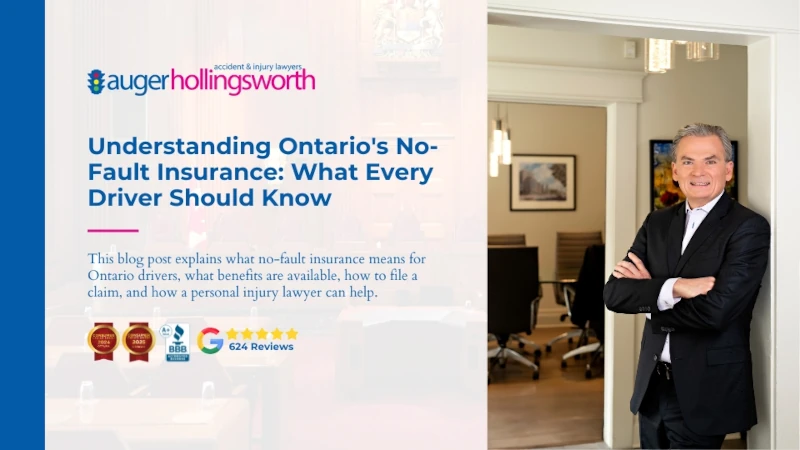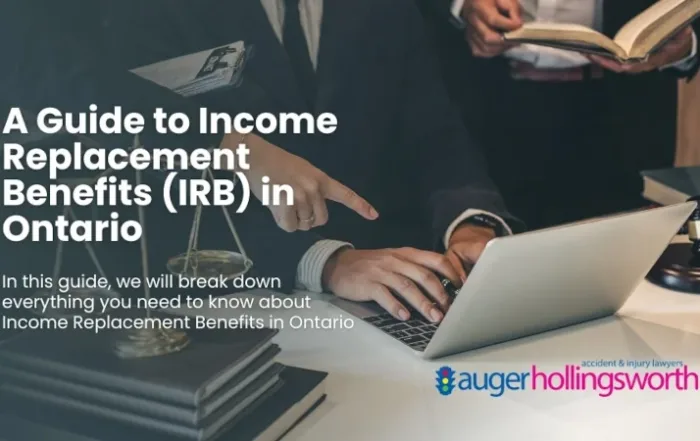Understanding Ontario’s No-Fault Insurance: What Every Driver Should Know

If you’ve recently been injured in a motor vehicle accident in Ontario, you’re probably hearing a lot about “no-fault insurance.” But what does that really mean for you? Many people mistakenly believe that “no-fault” means fault doesn’t matter or that you can’t sue an at-fault driver. In reality, Ontario’s auto insurance system is partly no-fault and partly fault-based.
The no-fault portion determines how accident benefits are paid, allowing you to access coverage from your own insurer regardless of who caused the accident.
The fault-based portion governs your ability to sue the other driver for additional compensation under specific legal thresholds.
This blog post explains what no-fault insurance means for Ontario drivers, what benefits are available, how to file a claim, and how a personal injury lawyer can help.
What Is No-Fault Insurance in Ontario?
Ontario’s no-fault auto insurance system means that if you’re injured in a car accident, you typically claim benefits from your own insurance company—regardless of who caused the crash. The framework is governed by Ontario’s Insurance Act and the Statutory Accident Benefits Schedule (SABS).
This system is designed to streamline access to benefits like medical treatment and income replacement without the need to prove fault. However, it doesn’t eliminate the possibility of suing the at-fault driver in certain situations. Fault still matters when it comes to determining premiums and eligibility for certain types of compensation.
Key Features of Ontario’s No-Fault System
Ontario’s no-fault system offers a mix of automatic benefits and legal limitations. Understanding the key elements helps you know what to expect after a crash and what options are available if your recovery journey becomes complicated.
Accident Benefits Regardless of Fault
Under SABS, you’re entitled to receive accident benefits even if you were responsible for the accident. These benefits include:
- Medical and rehabilitation benefits: Covers medical expenses not paid by OHIP, such as physiotherapy, occupational therapy, and medication.
- Attendant care benefits: Provides compensation for personal care services such as bathing, dressing, and grooming, typically assessed by an occupational therapist.
- Income replacement benefits: Pays up to 70% of your gross weekly income (to a capped amount) if you can’t work due to injuries.
- Caregiver and housekeeping benefits: Available if you have purchased optional coverage or if your injuries are deemed catastrophic.
Restrictions on Suing the At-Fault Driver
While accident benefits are accessible regardless of fault, suing the at-fault driver (called a tort claim) is only possible if your injuries meet certain criteria. To sue for pain and suffering, your injuries must be considered serious, permanent, and important or disfiguring. This is called meeting the threshold.
Even then, your damages are subject to a statutory deductible, which reduces your award unless your damages exceed a government-set amount.
Tort vs. Accident Benefits: What’s the Difference?
| Feature | Accident Benefits (SABS) | Tort Claim Against At-Fault Driver |
|---|---|---|
| Paid by | Your own insurer | At-fault driver's insurer |
| Fault matters? | No | Yes |
| Covers | Medical, rehab, income loss, care | Pain/suffering, full income loss, future care, out-of-pocket expenses, damages for family members |
| Legal threshold | None | Serious and permanent injury needed |
Even if you do not have your own insurance policy—such as when you are a pedestrian, cyclist, or passenger who does not own a vehicle—you are still entitled to Statutory Accident Benefits. The law establishes a priority system that determines which insurer is responsible. If no private insurance is available, you may still qualify for coverage through Ontario’s Motor Vehicle Accident Claims Fund. This ensures that every injured person has access to essential benefits, even in the absence of their own policy. Not sure where to send your application for accident benefits? A personal injury lawyer can assist you to determine where your application should go.
What Expenses Are Covered Under Accident Benefits?
Depending on your level of injury—categorized as minor, non-catastrophic, or catastrophic—you may be eligible for different benefit levels:
- Medical and rehabilitation costs: Expenses not covered by OHIP, including therapy, medications, and assistive devices.
- Income replacement: Up to 70% of pre-accident gross income, capped at a statutory maximum.
- Caregiver benefits: Weekly benefits if you’re unable to care for dependents, subject to eligibility.
- Housekeeping benefits: Available if you have catastrophic injuries or purchased optional benefits.
- Funeral and death benefits: Lump sum payments to surviving family members in fatal accidents.
- Visitors’ expenses: Reimbursement for reasonable travel costs to visit injured loved ones.
How to File a No-Fault Insurance Claim in Ontario
Filing a no-fault insurance claim in Ontario can feel overwhelming, especially while you’re still recovering. Here’s a practical breakdown of what you need to do and when, so you can avoid missing critical deadlines.
Steps to Take After a Collision
- Notify your insurer within 7 days. This starts the clock.
- Complete and submit your accident benefits forms within 30 days. These forms include:
- OCF-1: Application for accident benefits
- OCF-2: Employer’s confirmation of income
- OCF-3: Disability certificate from a health care provider
- Proceed cautiously when dealing with your insurer. While you will be expected to cooperate by attending medical assessments and responding to requests, it’s wise to consult a personal injury lawyer before sharing sensitive information or agreeing to any decisions that could limit your entitlement to benefits. Your lawyer can help ensure that your rights are protected throughout the process.
Timelines and Deadlines
- 7-day notice rule: Inform your insurer within 7 days of the accident.
- 30-day form submission: Submit accident benefits forms within 30 days.
- Two-year limitation period: You must dispute a denial of benefits within 2 years.
What Happens When There’s a Dispute With Your Insurance Company?
Insurance companies sometimes deny claims or underpay benefits. Disputes can take many forms. For example, your insurer may decide your injuries are only ‘minor,’ which drastically limits the medical and rehabilitation benefits available to you. Or they may cut off income replacement benefits too early, arguing you can return to work before you’re actually able. Some people are denied attendant care or housekeeping benefits despite having clear medical documentation. Others are denied funding for treatments that their healthcare providers strongly recommend. These disputes can be confusing and stressful, especially when you’re trying to focus on recovery.
Disputes are generally handled through the Licence Appeal Tribunal (LAT), which is an administrative tribunal specializing in accident benefit matters. The LAT is the exclusive forum for resolving SABS disputes. If you disagree with a LAT decision, you may be able to pursue a judicial review or, in certain cases, an appeal. Even if you handled your LAT hearing on your own, it is prudent to seek legal advice before pursuing either option. These processes involve complex legal standards and procedural requirements that a lawyer can help you navigate effectively.
How Fault Still Matters Under the No-Fault System
Although your accident benefits are paid regardless of fault, fault still has important implications:
- Insurance premiums: If you’re found at fault, your premiums may increase.
- Fault determination rules: Ontario uses regulations (O. Reg. 668) to assign fault percentages in common accident scenarios. This will not impact your access to SABS, but may impact whether you pay a deductible on your property damage claim.
- Future claims: Fault can influence your insurability or affect settlement discussions.
Optional Insurance Coverages to Consider
Standard auto policies may not offer enough coverage. Many drivers are unaware of terms like collision deductible, which refers to the out-of-pocket amount you must pay before your insurer covers damage to your vehicle. It’s also important to review whether your policy includes coverage for expenses like post-secondary educational expenses if you’re injured while attending school. These can be essential for younger or student-aged claimants.
Here are additional coverages you should consider:
- Increased income replacement: Raises the weekly maximum if you’re unable to work.
- Optional caregiver and housekeeping benefits: Available for non-catastrophic injuries.
- Direct Compensation – Property Damage (DCPD): Covers vehicle damage when another driver is at fault.
- Family Protection Endorsement: Protects you if the at-fault driver is uninsured or underinsured.
Review your auto insurance policy with a broker to ensure you aren’t underinsured.
It’s especially important to be aware of upcoming changes: Significant reforms are scheduled for July 2026 that will make more accident benefits optional instead of automatic. This means that unless you actively choose certain coverages when you renew or purchase your policy, you may not have access to them after a crash. These changes will place a greater burden on drivers to understand their policies and make informed decisions about the protection they want.
ALSO READ: A Guide to Income Replacement Benefits in Ontario
How a Personal Injury Lawyer Can Help You Navigate No-Fault Insurance
Navigating Ontario’s no-fault system can be overwhelming. A personal injury lawyer can:
- Maximize your accident benefits claim: Ensure you get all benefits you’re entitled to.
- Challenge benefit denials: Advocate on your behalf at the LAT or in court.
- Build a tort claim: Pursue additional compensation for pain and suffering or economic losses if your injuries meet the threshold. (A tort claim is basically a lawsuit against the driver who hit you.)
Our law firm has extensive experience helping Ontario accident victims fight for the compensation they deserve. We know how to front-load a case to influence reserves and settlement outcomes.
Frequently Asked Questions About Ontario No-Fault Insurance
Still have questions? You’re not alone. Many Ontarians have similar concerns when dealing with accident claims, especially when facing insurance company roadblocks or misinformation.
Can I still sue if I’m not at fault?
Yes, but only if your injuries meet the legal threshold of being serious and permanent. Because this threshold involves both medical and legal interpretations, it’s best to book a free consultation with a personal injury lawyer to evaluate your situation accurately.
What if I was a passenger or pedestrian?
You’re still entitled to accident benefits—even if you don’t have your own auto insurance policy. You may also have the right to sue the at-fault driver. A lawyer can help identify your best route to compensation and ensure you’re not missing out on available benefits.
How much does no-fault insurance cover?
Coverage depends on how your injury is classified: minor, non-catastrophic, or catastrophic. Optional benefits can increase your entitlements. A personal injury lawyer can help ensure your injuries are properly assessed so you receive the full compensation you deserve.
Can I switch insurance companies after a claim?
Yes, you can—but it may impact your future premiums or eligibility. If you’ve recently filed a claim or been found at fault, it’s wise to get advice from a lawyer before making any decisions about switching insurers.
For any of these concerns, speaking with a personal injury lawyer—at no cost—can give you the clarity and confidence you need to make informed choices. Book your free consultation today with Auger Hollingsworth.
Need help after a car accident? Contact the experienced car accident lawyers at Auger Hollingsworth to protect your rights and get the compensation you deserve. We serve accident victims across Ontario.














